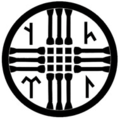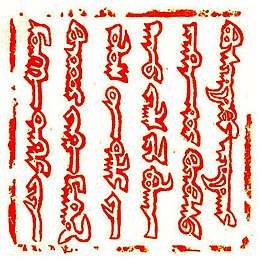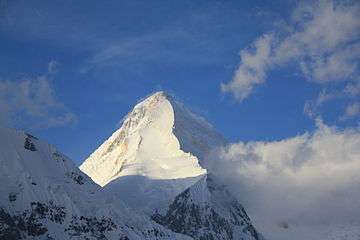Tengri
Tengri (Old Turkic: 𐱅𐰭𐰼𐰃, romanized: Teŋri/Тeŋiri or 𐰚𐰇𐰚:𐱅𐰭𐰼𐰃; Ottoman Turkish: طڭرى; Turkish: Tanrı; Bulgarian: Тангра; Proto-Turkic *teŋri / *taŋrɨ; Mongolian script: ᠲᠩᠷᠢ,[1] Tngri; Modern Mongolian: Тэнгэр, Tenger) is one of the names for the primary chief deity used by the early Turkic and Mongolic peoples.
| Part of a series on |
| Tengrism |
|---|
 |
| A Central Asian–Eurasian Steppe and partly Siberian–East Asian religion |
| Supreme deity |
| Other deities/spirits |
| Movements |
| Related movements |
| People |
| Priests |
| Scriptures |
| Holy places |
| Toponyms |
| Related conceptions |
|
|
Worship of Tengri is Tengrism. The core beings in Tengrism are the Heavenly-Father (Tengri/Tenger Etseg) and the Earth Mother (Eje/Gazar Eej). It involves shamanism, animism, totemism and ancestor worship.
Name

The oldest form of the name is recorded in Chinese annals from the 4th century BC, describing the beliefs of the Xiongnu. It takes the form 撑犁/Cheng-li, which is hypothesized to be a Chinese transcription of Tängri. (The Proto-Turkic form of the word has been reconstructed as *Teŋri or *Taŋrɨ.)[2] Alternatively, a reconstructed Altaic etymology from *T`aŋgiri ("oath" or "god") would emphasize the god's divinity rather than his domain over the sky.[3]
The Turkic form, Tengri, is attested in the 8th century Orkhon inscriptions as the Old Turkic form 𐱅𐰭𐰼𐰃 Teŋri. In modern Turkish, the derived word "Tanrı" is used as the generic word for "god", or for the Abrahamic God, and is used today by Turkish people to refer to any god. The supreme deity of the traditional religion of the Chuvash is Tură.[4]
Other reflexes of the name in modern languages include Mongolian: Тэнгэр ("sky"), Bulgarian: Тангра, Azerbaijani: Tanrı.
The Chinese word for "sky" 天 (Mandarin: tiān, Classical Chinese: thīn[5] and Japanese Han Dynasty loanword ten[5]) may also be related, possibly a loan from a prehistoric Central Asian language.[6]
However, this proposal conflicts with recent reconstructions of the Old Chinese pronunciation of the character "天" as "qhl'iin" (Zhengzhang)[7] or similar, with a lateral consonant (compare Wiktionary).
Linguist Stefan Georg has proposed that the Turkic word ultimately originates as a loanword from Proto-Yeniseian *tɨŋgVr- "high".[8]
History

Tengri was the national god of the Göktürks, described as the "god of the Turks" (Türük Tängrisi).[2] The Göktürk khans based their power on a mandate from Tengri. These rulers were generally accepted as the sons of Tengri who represented him on Earth. They wore titles such as tengrikut, kutluġ or kutalmysh, based on the belief that they attained the kut, the mighty spirit granted to these rulers by Tengri.[9]
Tengri was the chief deity worshipped by the ruling class of the Central Asian steppe peoples in 6th to 9th centuries (Turkic peoples, Mongols and Hungarians).[10] It lost its importance when the Uighuric kagans proclaimed Manichaeism the state religion in the 8th century.[11] The worship of Tengri was brought into Eastern Europe by the Huns and early Bulgars.
Tengri is considered to be the chief god who created all things. In addition to this celestial god, they also had minor divinities (Alps) that served the purposes of Tengri.[12] As Gök Tanrı, he was the father of the sun (Koyash) and moon (Ay Tanrı) and also Umay, Erlik, and sometimes Ülgen.
Mythology
Tengri was the main god of the Turkic pantheon, controlling the celestial sphere.[13] Tengri is considered to be strikingly similar to the Indo-European sky god, *Dyeus, and the structure of the reconstructed Proto-Indo-European religion is closer to that of the early Turks than to the religion of any people of Near Eastern or Mediterranean antiquity.[14]
The most important contemporary testimony of Tengri worship is found in the Old Turkic Orkhon inscriptions, dated to the early 8th century. Written in the so-called Orkhon script, these inscriptions record an account of the mythological origins of the Turks. The inscription dedicated to Kul Tigin includes the passages (in the translation provided by the Language Committee of Ministry of Culture and Information of the Republic of Kazakhstan): "When the blue sky [Tengri] above and the brown earth below were created, between them a human being was created. Over the human beings, my ancestors Bumin Kagan and Istemi Kagan ruled. They ruled people by Turkish laws, they led them and succeeded" (face 1, line 1); "Tengri creates death. Human beings have all been created in order to die" (Old Turkic: Öd Teŋri yasar kisi oγlu qop ölgeli törürmis), (face 2, line 9); "You passed away (lit.: 'went flying') until Tengri gives you life again" (face 2, line 14). Khagans ruled by the will of Tengri thought the ancient Turkic people and preserved these thoughts in the texts of the Orkhon inscriptions in the following way: "I, Tengri-like and Tengri-born Turk Bilge Kaghan, succeeded to the throne at this time" (Old Turkic: Teŋiriteg Teŋiride bolmuš Türük Bilge Qaγan bü ödüke olurtum).[15]
In Turkic mythology, Tengri is a pure, white goose that flies constantly over an endless expanse of water, which represents time. Beneath this water, Ak Ana ("White Mother") calls out to him saying "Create". To overcome his loneliness, Tengri creates Er Kishi, who is not as pure or as white as Tengri and together they set up the world. Er Kishi becomes a demonic character and strives to mislead people and draw them into its darkness. Tengri assumes the name Tengri Ülgen and withdraws into Heaven from which he tries to provide people with guidance through sacred animals that he sends among them. The Ak Tengris occupy the fifth level of Heaven. Shaman priests who want to reach Tengri Ülgen never get further than this level, where they convey their wishes to the divine guides. Returns to earth or to the human level take place in a goose-shaped vessel.[16]
Geographical names

- A pyramidal peak of the Tian Shan range between China, Kazakhstan, and Kyrgyzstan, is called "Khan Tengri." The Tian Shan itself is known in Uyghur as the Tanri Tagi.
- The Tangra Mountains on Livingston Island in the South Shetland Islands of Antarctica are also named after the deity.
- The Bulgars named a large mountain in the Rila mountain range after Tangra, although it was renamed in the 15th century to Musala ("Mountain of Allah") by the Ottoman Turks.
- Otgontenger, the highest mountain of the Khangai mountains in Mongolia.
- Tengger Desert, a desert in Inner Mongolia, China.
Modern revival
"Tengrism" is the term for a revival of Central Asian shamanism after the dissolution of the Soviet Union. In Kyrgyzstan, Tengrism was suggested as a Pan-Turkic national ideology following the 2005 presidential elections by an ideological committee chaired by state secretary Dastan Sarygulov.[17]
See also
- Tengger Cavalry, a Chinese folk metal band named after Tengri.
- Wolf Totem (Chinese novel)
Notes
- "ТЭНГЭР entry". Mongolian state dictionary (in Mongolian). Retrieved 2017-10-05.
- Jean-Paul Roux, Die alttürkische Mythologie, p. 255
- Sergei Starostin, Altaic etymology
- Tokarev, A. et al. 1987–1988. Mify narodov mira.
- Starling Etymology
- The connection was noted by Max Müller in Lectures on the Science of Religion (1870). Axel Schüssler (2007:495): "Because the deity Tiān came into prominence with the Zhou dynasty (a western state), a Central Asian origin has been suggested, note Mongolian tengri 'sky, heaven, heavenly deity'" (Shaughnessy Sino-Platonic Papers, July 1989, and others, like Shirakawa Shizuka before him)."
- 鄭張尚芳 《上古音系》(2003) 上海教育出版社
- Georg, Stefan (2001): Türkisch/Mongolisch tengri “Himmel/Gott” und seine Herkunft. Studia Etymologica Cracoviensia 6: 83–100.
- Käthe Uray-Kőhalmi, Jean-Paul Roux, Pertev N. Boratav, Edith Vertes. "Götter und Mythen in Zentralasien und Nordeurasien"; section: Jean-Paul Roux: "Die alttürkische Mythologie" ("Old Turkic Mythology") ISBN 3-12-909870-4
- "There is no doubt that between the 6th and 9th centuries Tengrism was the religion among the nomads of the steppes" Yazar András Róna-Tas, Hungarians and Europe in the early Middle Ages: an introduction to early Hungarian history, Yayıncı Central European University Press, 1999, ISBN 978-963-9116-48-1, p. 151.
- Buddhist studies review, Volumes 6–8, 1989, p. 164.
- Kaya, Polat. "Search For the Origin of the Crescent and Star Motif in the Turkish Flag", 1997.
- Abazov, Rafis. "Culture and Customs of the Central Asian Republics". Greenwood Press, 2006. page 62
- Mircea Eliade, John C. Holt, Patterns in comparative religion, 1958, p. 94.
- Göknil, Can. "Creation myths from Central Asia to Anatolia". Yapı Kredi Art Galleries, 1997.
- Erica Marat, Kyrgyz Government Unable to Produce New National Ideology , 22 February 2006, CACI Analyst, Central Asia-Caucasus Institute.
References
- Brent, Peter. The Mongol Empire: Genghis Khan: His Triumph and his Legacy. Book Club Associates, London. 1976.
- Sarangerel. Chosen by the Spirits. Destiny Books, Rochester (Vermont). 2001
- Schuessler, Axel. ABC Etymological Dictionary of Old Chinese. University of Hawaii Press. 2007.
- Georg, Stefan. „Türkisch/Mongolisch tängri “Himmel/Gott” und seine Herkunft", "Studia Etymologica Cracoviensia 6, 83–100
- Bruno J. Richtsfeld: Rezente ostmongolische Schöpfungs-, Ursprungs- und Weltkatastrophenerzählungen und ihre innerasiatischen Motiv- und Sujetparallelen; in: Münchner Beiträge zur Völkerkunde. Jahrbuch des Staatlichen Museums für Völkerkunde München 9 (2004), S. 225–274.
- Yves Bonnefoy, Asian mythologies, University of Chicago Press, 1993, ISBN 978-0-226-06456-7, p. 331.
Güngör, Harun (Winter 2013). "Tengrism as a religious and political phenomenon in Turkish World: Tengriyanstvo" (PDF). KARADENİZ – BLACK SEA – ЧЕРНОЕ МОРЕ. Erdoğan Altinkaynak. 19 (Winter 2013): 189–195. ISSN 1308-6200. Archived from the original (PDF) on 13 August 2016. Retrieved 19 June 2016.
External links
| Look up tanrı in Wiktionary, the free dictionary. |
- Tengri Teg Tengri Created Türk Bilge Kagan (Orkhon Inscriptions)
- Excerpt from Tengrianizm: Religion of Turks and Mongols, by Rafael Bezertinov (2000)
- Andrei Vinogradov Ak Jang in the contextof Altai religious tradition (2003)
- Hasan Bülent Paksoy, Tengri on Mars (2010)